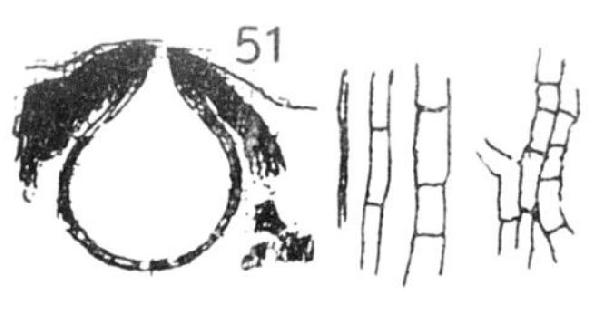Verrucaria pseudovirescens Servít
Preslia, 24: 379, 1952.
Synonyms:
Distribution: N - Ven (Anzi, Lich. Rar. Ven. 158, sub V. nigrescens var. virescens: Breuss & Berger 2010), Lig (GDOR 90). C - Sar (Nascimbene & al. 2023).
Description: Thallus crustose, episubstratic, areolate, 0.25-0.35 mm thick, dark olive-brown to brown, the areoles 0.5-0.9 mm wide, mostly flat, sometimes partially subdivided into smaller units. Cortex thin, small-celled (the cells 4-5 μm wide); algal layer 100-150 μm thick; medulla white to partially brownish in lower part, filled with substrate particles. Perithecia black, 1-2 per areole, almost completely immersed to 1/3 projecting, the apical part flat to convex, 0.25-0.45 mm wide. Involucrellum reaching down to ½–⅔ of the perithecium, 60-90 μm thick laterally, unsharply delimited and often fringed-eroded in lower part, partially surrounded by brownish medullary tissue; exciple globose, 0.2-0.4 mm across, the wall colourless to brown, c. 15 μm thick; hamathecium of weakly branched and anastomosing, 35-50 μm long periphyses and periphysoids, interascal filaments absent; hymenial gel hemiamyloid, I+ red (I+ blue at very low concentrations of I), K/I+ blue. Asci 8-spored, clavate, I-, fissitunicate, the wall thickened above, with an ocular chamber, dehiscent by extrusion of an endotunica to form a delicate rostrum, Verrucaria-type. Ascospores 1-celled, hyaline, ellipsoid, 17-22 x (7-)8-11 μm. Pycnidia black, small, immersed. Conidia straight or slightly curved, 5-6 x c. 1 μm. Photobiont chlorococcoid. Spot tests: K-, C-, KC-, P-, UV-. Chemistry: without lichen substances.Note: closely related to V. macrostoma, but differing in the thinner thallus, smaller perithecia and spores (see Breuss & Berger 2010), this species is known from a few localities only (Italy, Austria, Germany and Russia), but is probably more widespread, having been confused with V. macrostoma and V. nigrescens (Breuss 2016).
Growth form: Crustose
Substrata: rocks
Photobiont: green algae other than Trentepohlia
Reproductive strategy: mainly sexual
Poorly known taxon in need of further study
Commonnes-rarity: (info)
Alpine belt: absent
Subalpine belt: absent
Oromediterranean belt: absent
Montane belt: absent
Submediterranean belt: very rare
Padanian area: very rare
Humid submediterranean belt: absent
Humid mediterranean belt: absent
Dry mediterranean belt: absent

Predictive model
Herbarium samples
Growth form: Crustose
Substrata: rocks
Photobiont: green algae other than Trentepohlia
Reproductive strategy: mainly sexual
Poorly known taxon in need of further study
Commonnes-rarity: (info)
Alpine belt: absent
Subalpine belt: absent
Oromediterranean belt: absent
Montane belt: absent
Submediterranean belt: very rare
Padanian area: very rare
Humid submediterranean belt: absent
Humid mediterranean belt: absent
Dry mediterranean belt: absent

Predictive model
| Herbarium samples |
 INDEX FUNGORUM
INDEX FUNGORUM
 GBIF
GBIF
 DOLICHENS
DOLICHENS



